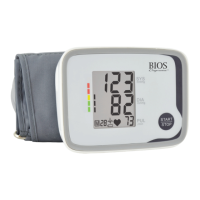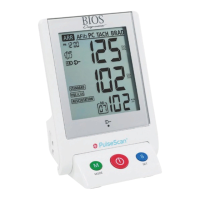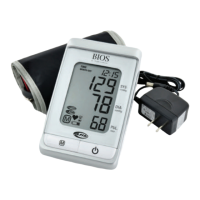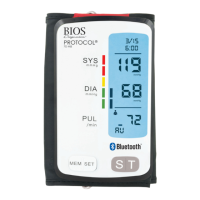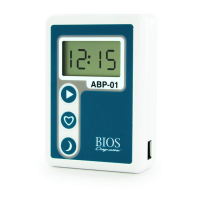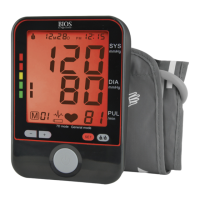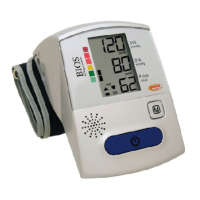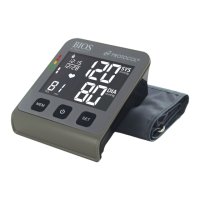Do you have a question about the BIOS Diagnostics BD850 and is the answer not in the manual?
Lists the BD850's automatic measurement, fuzzy logic, MAM/PAD technologies, and user memory.
Guides users to safety, care, and measurement guidelines for optimal device usage and health monitoring.
Provides crucial safety advice, including self-measurement interpretation and medication interaction.
Details proper handling, storage, cleaning, and battery precautions to maintain device functionality.
Explains blood pressure definition, systolic/diastolic values, and health risks of hypertension.
Defines normal, high, and low blood pressure ranges per WHO and advises medical consultation.
Addresses common user queries regarding blood pressure reading variations and the importance of home monitoring.
Introduces MAM (Average Mode) technology for enhanced measurement accuracy through averaging multiple readings.
Explains the rationale behind using MAM technology due to the inherent instability of human blood pressure.
Lists advantages of MAM technology, including reducing device scattering and movement effects.
Highlights the medical benefits of using the MAM technology, primarily improved accuracy.
Details the flowchart and steps involved in the MAM measurement sequence.
Provides an overview of the BD850 blood pressure monitor's components and their functions.
Explains the various elements displayed on the BD850's LCD screen and the symbol guide.
Provides step-by-step instructions for correctly inserting the batteries into the device.
Guides users on choosing the appropriate cuff size based on arm circumference for accurate measurements.
Details the proper method for storing the blood pressure cuff to protect its delicate components.
Explains how to set the device's time, date, and select the user profile for personalized measurements.
Guides users on activating or deactivating the MAM (Averaging Mode) for enhanced measurement accuracy.
Provides essential guidelines for achieving accurate blood pressure readings, covering preparation and environment.
Details preparation steps before measurement, including avoiding exertion, relaxing, and optimal timing.
Identifies common errors that can affect measurement accuracy, such as arm position and cuff fit.
Provides detailed instructions on how to correctly position and secure the blood pressure cuff on the arm.
Outlines the steps for performing a blood pressure measurement using the BD850 monitor.
Explains the specific procedure for taking measurements when the MAM feature is enabled.
Explains the PAD symbol, indicating pulse irregularities, and when to consult a doctor.
Describes the color-coded indicator on the display that shows blood pressure classification based on WHO standards.
| Brand | BIOS Diagnostics |
|---|---|
| Model | BD850 |
| Category | Blood Pressure Monitor |
| Language | English |
